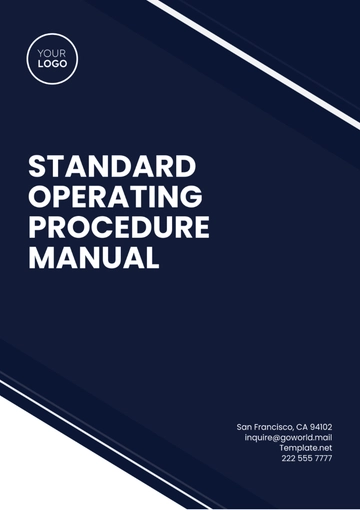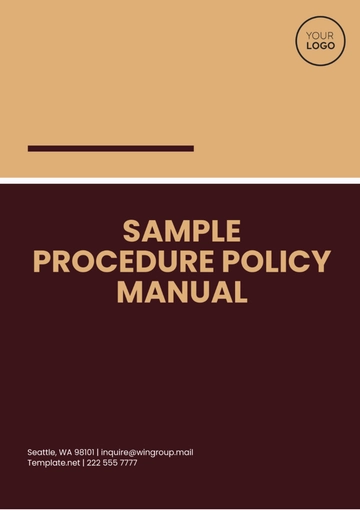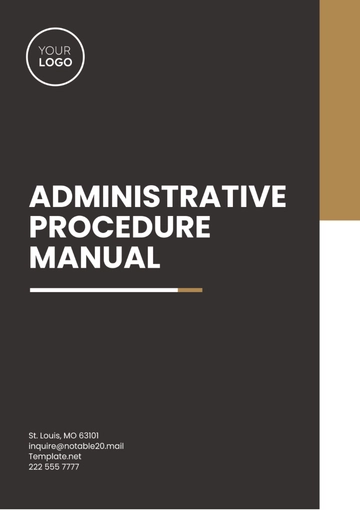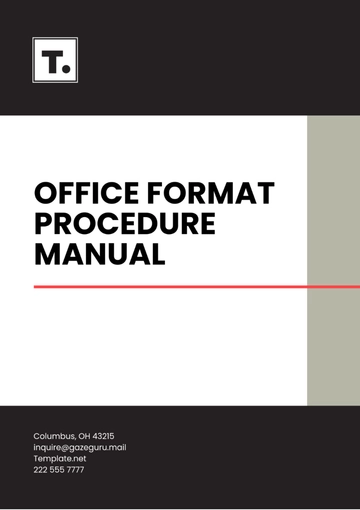Free Nursing Home Emergency Procedures Training Manual

I. Introduction
Welcome to the Emergency Procedures Training Manual for [Your Company Name]. This manual is designed to provide guidance and instructions to our dedicated staff members on how to effectively respond to various emergency situations that may arise within our facility. By familiarizing yourself with the procedures outlined in this manual and participating in regular training sessions, you play a crucial role in ensuring the safety and well-being of our residents and staff.
II. Emergency Preparedness Planning
At [Your Company Name], we prioritize the safety and security of our residents and staff. Our emergency preparedness planning involves thorough risk assessments, identification of potential hazards, and the development of comprehensive emergency response procedures. We collaborate closely with local authorities, emergency responders, and community partners to ensure a coordinated and effective response to emergencies.
III. Types of Emergencies
Our facility may encounter various types of emergencies, including but not limited to:
Natural disasters such as earthquakes, floods, hurricanes, or wildfires.
Medical emergencies such as cardiac arrest, strokes, or respiratory distress.
Fire emergencies.
Power outages or utility failures.
Security threats or violent incidents.
IV. Emergency Response Procedures
A. Natural Disasters
Natural disasters can pose significant risks to the safety and well-being of our residents and staff. It is essential to be prepared and know how to respond effectively to different types of natural disasters. Below are specific emergency response procedures for various natural disasters:
Earthquake:
Drop, cover, and hold on: Immediately take cover under a sturdy piece of furniture or against an interior wall. Protect your head and neck.
Evacuate if necessary: If the building is compromised or if evacuation is ordered, assist residents in moving to a safe location away from potential hazards such as falling debris or structural damage.
Account for all residents: Conduct a headcount to ensure all residents are safe and accounted for. Report any missing individuals to emergency responders.
Flood:
Monitor weather alerts: Stay informed about flood warnings and evacuation orders issued by local authorities. Act quickly to evacuate if instructed to do so.
Secure the facility: Move valuable equipment and supplies to higher ground if possible. Use sandbags or other barriers to prevent water from entering the building.
Evacuate to higher ground: If flooding occurs or is imminent, evacuate residents to a safe location on higher ground. Use designated evacuation routes and assist residents with mobility impairments.
Hurricane or Tropical Storm:
Prepare in advance: Stock up on essential supplies such as food, water, medications, and emergency supplies. Secure loose objects and reinforce windows and doors.
Evacuate if necessary: Follow evacuation orders issued by local authorities. Assist residents in evacuating to designated shelters or safe locations outside the evacuation zone.
Monitor weather updates: Stay informed about the storm's progress and potential impacts. Keep residents and staff updated on the latest developments and safety precautions.
Wildfire:
Monitor wildfire alerts: Stay informed about wildfire warnings and evacuation orders issued by local authorities. Prepare to evacuate if directed to do so.
Close windows and doors: Keep windows and doors closed to prevent smoke from entering the building. Seal gaps and vents with tape or damp towels.
Evacuate to a safe location: If wildfires approach the area or if evacuation is ordered, evacuate residents to a safe location away from the fire zone. Follow designated evacuation routes and avoid areas at risk of fire.
Tornado:
Seek shelter immediately: Move residents to the lowest level of the building, away from windows and exterior walls. Seek shelter in interior rooms such as hallways, bathrooms, or basements.
Take cover: Instruct residents to crouch down and cover their heads with their hands to protect against flying debris and falling objects.
Account for all residents: After the tornado has passed, conduct a headcount to ensure all residents are safe. Check for injuries and provide first aid as needed.
Severe Storms:
Monitor weather alerts: Stay informed about severe weather warnings issued by local authorities. Take precautions to secure the facility and prepare for potential power outages.
Stay indoors: Keep residents indoors during severe storms to protect against lightning, strong winds, and hail. Close windows and doors to minimize the risk of injury.
Prepare emergency supplies: Have emergency supplies readily available, including flashlights, batteries, first aid kits, and blankets. Be prepared to provide assistance to residents as needed.
B. Medical Emergencies
Medical emergencies can occur suddenly and require prompt intervention to ensure the well-being of residents. Proper training and adherence to established procedures are crucial for an effective response. Below are specific emergency response procedures for medical emergencies:
Cardiac Arrest:
Call for help: Immediately activate the emergency response system and call for assistance from trained medical personnel.
Initiate CPR: Begin cardiopulmonary resuscitation (CPR) by performing chest compressions and rescue breathing according to current guidelines.
Use automated external defibrillator (AED): If available, use an AED to deliver an electric shock to restore normal heart rhythm.
Continue CPR until help arrives: Maintain CPR until advanced medical assistance arrives and takes over care.
Stroke:
Recognize the signs: Be familiar with the signs of stroke, including facial drooping, arm weakness, and slurred speech.
Call for help: Activate the emergency response system and notify medical personnel immediately.
Keep the resident comfortable: Position the resident in a comfortable and supported position while waiting for medical assistance.
Provide reassurance: Offer reassurance to the resident and keep them calm while waiting for medical evaluation and treatment.
Respiratory Distress:
Assess airway and breathing: Check for signs of respiratory distress, including difficulty breathing, wheezing, or gasping for air.
Administer oxygen: If available, administer supplemental oxygen to improve oxygenation and relieve respiratory distress.
Position for comfort: Assist the resident into a position that facilitates breathing, such as sitting upright or leaning forward.
Monitor vital signs: Monitor the resident's vital signs closely and report any significant changes to medical personnel.
Allergic Reactions:
Identify allergen exposure: Determine the cause of the allergic reaction and remove the resident from the source of exposure if possible.
Administer epinephrine: If the resident has a known severe allergy and carries an epinephrine auto-injector, assist with administering the medication according to prescribed instructions.
Monitor for signs of anaphylaxis: Watch for symptoms of anaphylaxis, such as difficulty breathing, swelling of the face or throat, and a rapid heartbeat.
Seek medical attention: Even if symptoms improve after administering epinephrine, it is essential to seek medical evaluation to prevent recurrence or complications.
Seizures:
Ensure safety: Clear the area around the resident to prevent injury during the seizure episode. Do not restrain the resident unless necessary to prevent harm.
Protect the head: Place a soft object or cushion under the resident's head to protect against injury.
Time the seizure: Note the duration of the seizure and observe for any changes in behavior or consciousness.
Provide comfort and support: Stay with the resident during the seizure episode and offer reassurance. After the seizure subsides, check for injuries and offer assistance as needed.
Choking:
Assess the severity: Determine if the resident is experiencing partial or complete obstruction of the airway.
Perform abdominal thrusts: If the resident is conscious and experiencing severe choking, perform abdominal thrusts (Heimlich maneuver) to dislodge the obstructing object.
Monitor airway: If the resident becomes unconscious, perform CPR with chest compressions and rescue breathing. Check the mouth for any visible obstructions and remove if possible.
C. Fire Emergencies
Upon discovering a fire, activate the nearest fire alarm and evacuate residents to safe areas using established evacuation routes. Use fire extinguishers if safe to do so and assist residents with mobility impairments. Never use elevators during a fire emergency.
D. Power Outages or Utility Failures
During power outages or utility failures, ensure the safety and comfort of residents by providing alternative lighting, heating, and communication devices as needed. Follow protocols for managing essential services and coordinate with utility companies to resolve the issue promptly.
E. Security Threats or Violent Incidents
In the event of a security threat or violent incident, prioritize the safety of residents and staff. Follow established lockdown procedures, contact emergency services, and provide assistance to those in need. Do not engage with the perpetrator and await instructions from law enforcement.
V. Communication Protocols
Effective communication is essential during emergencies. Utilize communication devices such as two-way radios, phones, or intercom systems to relay important information to staff, residents, and families. Designate specific staff members responsible for communicating with emergency responders and authorities.
VI. Evacuation Procedures
Establish clear evacuation routes and assembly areas for residents and staff. Conduct regular drills to familiarize everyone with evacuation procedures and ensure a swift and orderly evacuation in case of emergency. Assign staff members to assist residents with mobility impairments or special needs during evacuation.
VII. Shelter-in-Place Procedures
In certain emergencies, such as severe weather or hazardous material incidents, sheltering in place may be necessary. Identify designated shelter areas within the facility and ensure they are equipped with necessary supplies and resources. Follow instructions from emergency authorities and remain indoors until it is safe to evacuate.
VIII. Staff Responsibilities
Each staff member has specific responsibilities during emergencies, including but not limited to:
Assisting with evacuation and sheltering procedures.
Providing medical care and support to residents.
Communicating with emergency responders and authorities.
Maintaining calm and reassuring residents and families.
Following established protocols and procedures.
IX. Resident Responsibilities
Residents play an important role in their own safety during emergencies. Encourage residents to familiarize themselves with emergency procedures, participate in drills, and follow staff instructions. Remind residents to stay calm, remain in designated safe areas, and avoid unnecessary risks.
X. Training and Drills
Regular training sessions and emergency drills are essential for ensuring staff readiness and effectiveness during emergencies. Participate actively in training activities, review emergency procedures regularly, and provide feedback for continuous improvement. Mock scenarios and tabletop exercises can enhance preparedness and response capabilities.
XI. Equipment and Resources
Maintain an inventory of emergency equipment and resources, including first aid kits, fire extinguishers, emergency lighting, and communication devices. Ensure equipment is properly maintained, readily accessible, and functional at all times. Replace expired supplies as needed and report any deficiencies promptly.
XII. Reporting and Documentation
Accurate documentation of emergency events, responses, and outcomes is essential for learning from experiences and improving emergency preparedness. Complete incident reports promptly following any emergency situation and include relevant details such as timelines, actions taken, and outcomes. Document observations and lessons learned for future reference.
XIII. Review and Updates
Periodically review and update the Emergency Procedures Training Manual to reflect changes in regulations, best practices, or facility-specific considerations. Seek input from staff members, residents, and stakeholders to ensure the manual remains relevant and effective. Distribute revised versions of the manual and provide training on updated procedures as needed.
By adhering to the procedures outlined in this manual and working together as a team, we can ensure a safe and secure environment for all residents and staff at [Your Company Name].
- 100% Customizable, free editor
- Access 1 Million+ Templates, photo’s & graphics
- Download or share as a template
- Click and replace photos, graphics, text, backgrounds
- Resize, crop, AI write & more
- Access advanced editor
Prepare nursing home staff for emergencies with Template.net's Nursing Home Emergency Procedures Training Manual Template. Easily accessible and editable in our AI Editor Tool, this customizable template provides a structured format for developing comprehensive training manuals covering emergency response protocols, including evacuation procedures, medical emergencies, fire safety, and disaster preparedness.





























